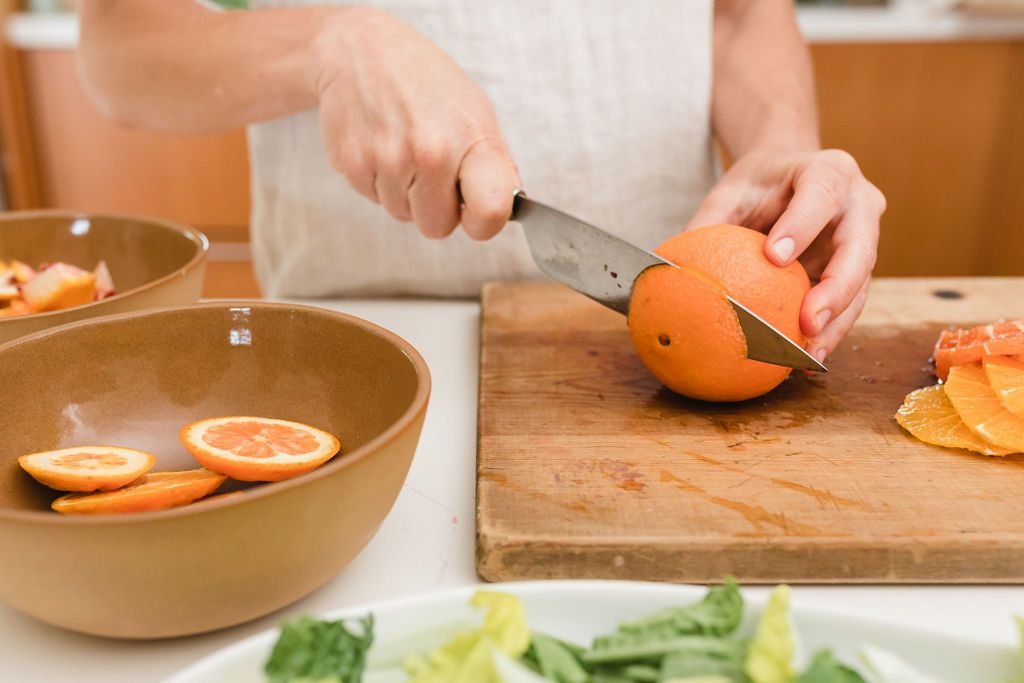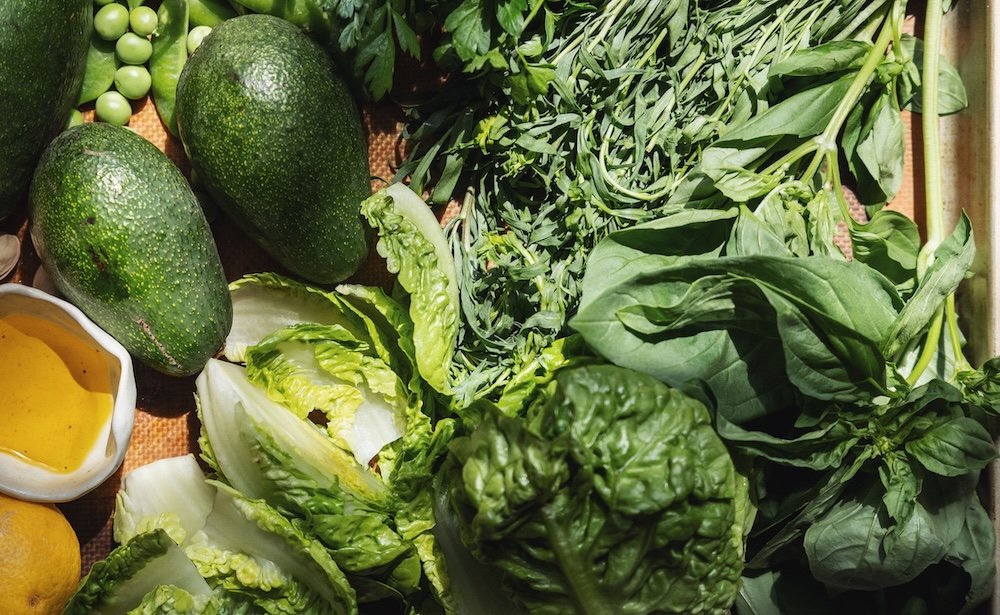Nothing will quench your thirst in the summer like a fresh, homemade vegetable juice.
Juicing is an excellent way to expand your diet and get a wider variety of nutrients.
Here at Hitchcock Farms, we love finding new ways to enjoy our healthy and delicious produce.
In this blog, we're sharing our favorite vegetable juice recipes and our juicing pro tips.
Juicing Veggies: Prep Basics
1. Choose the Right Produce Pairing
Almost all fruits and veggies can be juiced, but you'll get the best results by choosing produce combinations that complement each other.
Pure vegetable juice can be very potent on its own, so pairing vegetables with sweeter fruits can help to create a better balance.
Apples and pears, for instance, make delicious additions to vegetable juice.
You should consider the water content of your ingredients when choosing combinations, too.
Pairing higher-moisture vegetables like cucumber with lower-moisture produce like kale will give you a better yield.
Look into the nutrient profiles of your ingredients, too.
Try to pair fruits and veggies that offer different nutrients to maximize the health benefits of the juice.
2. Select the Right Juicer
If you love fruit and vegetable juice, a juicer is a worthy investment for your home kitchen.
Here are three of the most popular types:
Masticating Juicer
A masticating juicer, also known as a cold-press juicer, uses a slowly spinning auger to extract the juice.
Pros: The process uses no heat, so it preserves the nutrients in the produce.
Cons: Masticating juicers are typically slower and more expensive than centrifugal models, and they require more time for cleanup due to their multiple parts.
Centrifugal Juicer
A centrifugal juicer uses a quickly spinning blade to chop the produce. Then, centrifugal force pushes the juice through a mesh screen, separating it from the pulp.
Pros: Centrifugal juicers work faster than masticating juicers and are more budget-friendly.
Cons: Their mechanism can slightly degrade the quality of the juice.
Manual Juicer
Manual juicers use a hand press or hand crank to extract the fruit or vegetable juice.
Pros: They're the least expensive option, and they're small and easy to store or transport.
Cons: They may not be able to process all types of vegetables, such as leafy greens.
3. Prep the Vegetables
To prepare your farm-fresh vegetables for juicing, start by thoroughly washing them.
Fruits with inedible peels, like oranges and pineapples, need to be peeled before juicing.
You can leave the peels on most other fruits and vegetables, though.
8 Easy Farm-Fresh Vegetable Juice Ideas
1. Green Juice With Kale and Apples
If you struggle to get your leafy greens and vegetables throughout the day, starting your morning with this fresh green juice could be the perfect solution.
Recipe:
Add chopped cucumber, celery, apple, and ginger to a blender with one cup of water, and blend until smooth.
Add the kale leaves and lemon juice and continue blending until smooth.
Pour the puree over a fine mesh strainer to remove the pulp, using a rubber spatula to push down on the pulp until all the juice has been collected.
Tip: Leave the peels on the cucumber and apple to get all the nutrients the produce has to offer.
Benefits:
Kale is rich in vitamins A and C, which support eye health.
It contains calcium, which promotes heart and bone health.
2. Cabbage Green Juice
Cabbage is often overlooked for juicing, but this simple cabbage juice recipe is packed with nutrients.
Recipe:
Prepare and wash two cabbage leaves, one medium apple, one peeled lemon, one to two leaves of chard, three-quarters cup of kale, and one celery stalk.
Slowly feed the produce into the juicer, including the leafy green stems.
Tip: Swap out traditional cabbage with napa cabbage to get a slightly sweeter and milder flavor.
Benefits:
Cabbage promotes heart health and improves your circulatory system.
It’s rich in calcium, which can prevent osteoporosis.
3. Brussels Sprouts Juice
Brussels sprouts may be best known as a roasted or sautéed holiday side dish, but raw sprouts can actually produce a delicious green juice.
Recipe:
Wash the fresh sprouts, slice off the stalks, and cut the sprouts into small pieces before feeding them into the juicer.
Add apple, carrots, celery, cucumber, and lemon.
Tip: Soaking Brussels sprouts in water for a few hours before juicing can increase their yield.
Benefits:
Brussels sprouts have collagen, an essential protein for skin elasticity and bone health.
Because the sprouts are high in fiber and low in fat, they can reduce cholesterol and aid in weight loss.
4. Tomato Vegetable Juice
Tomato juice is one of the most popular vegetable juices on the market, but making it at home with this recipe will provide even fresher and more delicious results.
Recipe:
Add diced tomatoes, carrots, and beets to a saucepan with Worcestershire sauce, salt, and pepper.
Simmer the vegetables for 20 minutes, then add spinach and parsley and continue simmering.
Add the mixture to a blender with water and puree until completely smooth.
Strain the juice through a sieve to remove the pulp.
Tip: Cooking your tomatoes before putting them in vegetable juice will create a deeper flavor and smoother texture.
Benefits:
Tomato juice is rich in potassium, magnesium, and vitamin C, all of which reduce inflammation.
The lycopene in tomato juice may prevent type 2 diabetes, heart disease, and prostate cancer.
5. Carrot Ginger Juice
Carrots and ginger combine to create a wonderfully sweet and refreshing juice that could be a great home remedy if you're feeling under the weather.
Recipe:
Use your juicer to extract the juice from four carrots and one inch of ginger.
Add the juice of one lemon to the mixture.
Add salt to taste if you prefer savory flavors, and add honey or orange juice for a sweeter drink.
Tip: After juicing the carrots and ginger, add some water to extract as much juice as possible from the pulp.
Benefits:
Carrots are rich in carotenoids, which may reduce the risk of certain types of cancer.
Carrots contain vitamins A and C, which support immunity.
Ginger has powerful benefits for your digestive health.
6. Beet Juice
While raw beets have a strong, earthy flavor that some find off-putting, preparing a beet juice with some sweet or zesty additions can help make the veggie more palatable.
Recipe:
Wash and cut one beet, one large apple, two celery stalks, and two carrots.
Feed the vegetables into your juicer with a small piece of ginger.
Squeeze half of a lemon into the juice and pour the juice into a chilled glass.
Tip: Make the most out of your produce by juicing the beet stems and leaves along with the root.
Benefits:
Beets contain nitrates, compounds that lower your blood pressure.
Drinking beet juice before exercising can improve your performance.
Beets may support liver health by preventing fatty deposits.
7. Orange Celery Juice
Celery juice became a social media phenomenon a few years ago, and celery continues to be one of the most popular vegetables for juicing thanks to its numerous health benefits.
Recipe:
Feed peeled and chopped celery and carrots into the juicer, followed by orange juice.
Add extra orange juice to the mixture to taste.
Garnish with a celery stick and celery leaves.
Tip: If you find that the celery juice contains too much pulp, strain it through a coffee filter or cheesecloth.
Benefits:
Celery contains anti-inflammatory compounds that can promote gut health and reduce your risk of heart disease and cancer.
It’s rich in vitamin K, potassium, and folate.
8. Cucumber Mint Juice
On a hot summer day, few things are more refreshing than a cold glass of this cucumber mint juice.
Recipe:
Add chopped cucumber, mint, lemon juice, salt, and ice to a food processor and blend until smooth.
Strain the juice through a fine mesh strainer or cheesecloth to remove the pulp.
Season with more salt or lemon juice to taste, and garnish with a sprig of mint.
Tip: To get the best flavor, cut off the tip of the cucumber and rub the cut slice against the exposed end of the vegetable. This will bring out a white foam that you can wash away, and you'll be left with a sweeter cucumber.
Benefits:
Cucumbers are high in potassium, so their juice may help lower blood pressure.
Cucumber juice can promote healthy skin.
Juicing Tips
Juicing may seem simple, but it can take some time to learn how to make the most of your juicer and to find your favorite recipes.
Here are some juicing pro tips to keep in mind as you begin your juicing journey:
As a general rule, juices made from 80% vegetables and 20% fruits will have an optimal mix of nutrients.
Add lemon to your juice to extend its lifespan by a few days.
Switch up your juice recipes regularly so that you benefit from taking in a wide variety of vitamins and nutrients.
To get the most juice out of leafy greens like spinach or kale, roll them up and place them between two slices of celery, apple, cucumber, or another hard ingredient.
When feeding produce into your juicer, alternate between juicier veggies like celery and cucumber and more difficult ingredients like ginger or kale. This will help flush out the juicer.
Local, farm-fresh vegetables like our offerings from Hitchcock Farms have the best nutrition and flavor profiles because they're picked and sold at peak ripeness.
If you prepare juice in batches, store it in full, airtight containers in the refrigerator. You can also freeze juice and defrost it by moving the container to the fridge or to a bowl of cold water.
Rinse your juicer as soon as you finish using it so the pulp doesn't harden onto the machine.
Embrace Your Health and Enjoy Your Veggies
We hope these recipes offer inspiration and spark your creativity for healthy summer dining.
Whether you're looking for fresh juice recipes for your home kitchen or new menu options for your commercial kitchen, Hitchcock Farms is here to help.
As one of California's leading produce suppliers, you can count on us to deliver the best ingredients for your recipes.
FAQ
How do I store vegetable juice?
The best way to store vegetable juice is in an airtight glass jar in the refrigerator. Most homemade juices last two to three days in the fridge.
What are the benefits of vegetable juices?
Drinking vegetable juice is an easy and fun way to add nutrients to your diet.
Different vegetables have different nutrient profiles.
Overall, research shows that drinking 100% juice can lead to positive outcomes, including better cognitive functioning, reduced blood pressure, and a healthier gut microbiome.
Is it OK to drink vegetable juice every day?
Vegetable juice is perfectly healthy in moderation, but healthcare professionals warn against using juice as a substitute for all of your daily fruits and veggies.
Juice lacks the fiber and protein needed for a complete and balanced diet, so it should be an addition to your wellness regimen, not a substitute for full meals.

![8 Fresh Vegetable Juice Recipes to Try This Summer [2025]](https://images.squarespace-cdn.com/content/v1/5d96d524052c897425394aaf/1750697331694-UOMHEJZLRAVOR9PZVV6W/vegetable-juice-recipes.jpeg)







